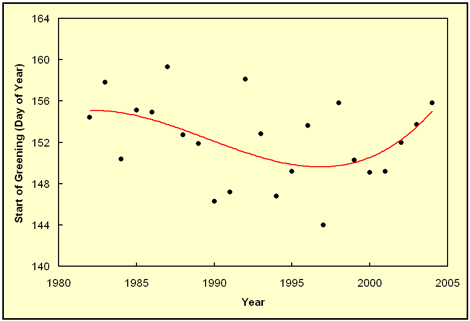Reference
Delbart, N., Le Toan, T., Kergoat, L. and Fedotova, V. 2006. Remote sensing of spring phenology in boreal regions: A free of snow-effect method using NOAA-AVHRR and SPOT-VGT data (1982-2004). Remote Sensing of Environment 101: 52-62.
What was done
The authors developed "a methodology for determining the date of onset of greening in the 1982-2004 period using SPOT-VEGETATION (VGT) and NOAA Advanced Very High Resolution Radiometer (AVHRR) data." This was done for the vast area of northern Eurasia that is located between latitudes 50°N and 72°N and between longitudes 45°E and 180°E.
What was learned
With respect to the onset of greening in northern Eurasia each spring, Delbert et al. say they found "an advance of 7.8 days in average" from 1982 to 1991. After 1991, however, they say the onset of greening "varies irregularly until 1999," after which they say it "increases continuously between year 2000 and year 2004." Another thing that strikes us about this latter period is that the scatter in the data is much reduced from what it was over the prior period; and Delbart et al. note that the 2000-2004 period was characterized by an ever-increasing delay in spring phenology, "so that over the 1982-2004 period the advance is only 3.5 days on average over the study area."
In terms of the starting and end points of the data series (1982 and 2004), however, there is no advance in spring phenology. In fact, there is a net delay in the onset of greening of northern Eurasia of approximately 1.5 days. But perhaps the most valid description of all of the data set is that provided by the third-degree polynomial we have fit to it, as shown in the figure below, where it can be seen that the long slow advance of spring greening that prevailed over the initial two-thirds of the series reverses course over the last third of its range to return to where it was initially, with a strong suggestion that it may continue its new course for some years into the future.

Figure 1. Yearly history of the spring "greening" of northern Eurasia's vegetation.
What it means
If the advancement and retraction of the onset of spring greening portrayed in the figure above is driven (as nearly everyone suggests it is) by warming and cooling, respectively, it would appear that (1) there was no net change in the thermal climate of northern Eurasia between 1982 and 2004, and that (2) the vast area looks primed for a continuation of the recent (implied) cooling trend for some time into the future.




